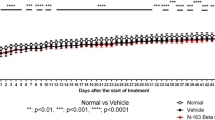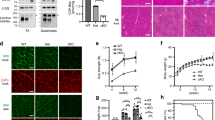Abstract
Distal myopathy with rimmed vacuoles (DMRV)–hereditary inclusion body myopathy (hIBM) is an adult-onset, moderately progressive autosomal recessive myopathy; eventually, affected individuals become wheelchair bound1. It is characterized clinically by skeletal muscle atrophy and weakness, and pathologically by rimmed vacuoles, which are actually accumulations of autophagic vacuoles2,3,4, scattered angular fibers and intracellular accumulation of amyloid and other proteins5. To date, no therapy is available for this debilitating myopathy, primarily because the disease pathomechanism has been enigmatic. It is known that the disease gene underlying DMRV-hIBM is GNE, encoding glucosamine (UDP-N-acetyl)-2-epimerase and N-acetylmannosamine kinase6,7,8—two essential enzymes in sialic acid biosynthesis9. It is still unclear, however, whether decreased sialic acid production causes muscle degeneration, as GNE has been proposed to have roles other than for sialic acid biosynthesis10,11,12. By showing that muscle atrophy and weakness are completely prevented in a mouse model of DMRV-hIBM after treatment with sialic acid metabolites orally, we provide evidence that hyposialylation is indeed one of the key factors in the pathomechanism of DMRV-hIBM. These results support the notion that DMRV-hIBM can potentially be treated simply by giving sialic acids, a strategy that could be applied in clinical trials in the near future.
This is a preview of subscription content, access via your institution
Access options
Subscribe to this journal
Receive 12 print issues and online access
$209.00 per year
only $17.42 per issue
Buy this article
- Purchase on Springer Link
- Instant access to full article PDF
Prices may be subject to local taxes which are calculated during checkout




Similar content being viewed by others
References
Nonaka, I., Noguchi, S. & Nishino, I. Distal myopathy with rimmed vacuoles and hereditary inclusion body myopathy. Curr. Neurol. Neurosci. Rep. 5, 61–65 (2005).
Nishino, I. et al. Molecular pathomechanism of distal myopathy with rimmed vacuoles. Acta Myol. 24, 80–83 (2005).
Tsuruta, Y. et al. Expression of the lysosome-associated membrane proteins in myopathies with rimmed vacuoles. Acta Neuropathol. 101, 579–584 (2001).
Malicdan, M.C., Noguchi, S. & Nishino, I. Autophagy in a mouse model of distal myopathy with rimmed vacuoles or hereditary inclusion body myopathy. Autophagy 3, 396–398 (2007).
Askanas, V. & Engel, W.K. Hereditary inclusion myopathies. in. The molecular and genetic basis of neurologic and psychiatric disease (eds. Rosenberg, R.N., Prusiner, S.B., DiMauro, S., Barchi, R.L. & Nestler, E.J.) 501–509 (Butterworth–Heinemann, Woburn, Massachusetts, 2003).
Eisenberg, I. et al. The UDP–N-acetylglucosamine 2-epimerase/N-acetylmannosamine kinase gene is mutated in recessive hereditary inclusion body myopathy. Nat. Genet. 29, 83–87 (2001).
Ikeuchi, T. et al. Gene locus for autosomal recessive distal myopathy with rimmed vacuoles maps to chromosome 9. Ann. Neurol. 41, 432–437 (1997).
Nishino, I. et al. Distal myopathy with rimmed vacuoles is allelic to hereditary inclusion body myopathy. Neurology 59, 1689–1693 (2002).
Keppler, O.T. et al. UDP–GlcNAc 2-epimerase: a regulator of cell surface sialylation. Science 284, 1372–1376 (1999).
Krause, S. et al. Localization of UDP–GlcNAc 2-epimerase/ManAc kinase (GNE) in the Golgi complex and the nucleus of mammalian cells. Exp. Cell Res. 304, 365–379 (2005).
Wang, Z., Sun, Z., Li, A.V. & Yarema, K.J. Roles for GNE outside of sialic acid biosynthesis: modulation of sialyltransferase and BiP expression, GM3 and GD3 biosynthesis, proliferation and apoptosis, and ERK1/2 phosphorylation. J. Biol. Chem. 281, 27016–27028 (2006).
Amsili, S. et al. UDP–N-acetylglucosamine 2-epimerase/N-acetylmannosamine kinase (GNE) binds to α-actinin 1: novel pathways in skeletal muscle? PLoS One 3, e2477 (2008).
Noguchi, S. et al. Reduction of UDP–N-acetylglucosamine 2-epimerase/N-acetylmannosamine kinase activity and sialylation in distal myopathy with rimmed vacuoles. J. Biol. Chem. 279, 11402–11407 (2004).
Broccolini, A. et al. Hyposialylation of neprilysin possibly affects its expression and enzymatic activity in hereditary inclusion–body myopathy muscle. J. Neurochem. 105, 971–981 (2008).
Malicdan, M.C., Noguchi, S., Nonaka, I., Hayashi, Y.K. & Nishino, I. A Gne knockout mouse expressing human GNE D176V mutation develops features similar to distal myopathy with rimmed vacuoles or hereditary inclusion body myopathy. Hum. Mol. Genet. 16, 2669–2682 (2007).
Malicdan, M.C., Noguchi, S., Hayashi, Y.K. & Nishino, I. Muscle weakness correlates with muscle atrophy and precedes the development of inclusion body or rimmed vacuoles in the mouse model of DMRV/hIBM. Physiol. Genomics 35, 106–115 (2008).
Comb, D.G. & Roseman, S. Composition and enzymatic synthesis of N-acetylneuraminic (sialic) acid. J. Am. Chem. Soc. 80, 497–499 (1958).
Thomas, G.H., Scocca, J., Miller, C. & Reynolds, L.W. Accumulation of N-acetylneuraminic acid (sialic acid) in human fibroblasts cultured in the presence of N-mannosamine. Biochim. Biophys. Acta 846, 37–43 (1985).
Galeano, B. et al. Mutation in the key enzyme of sialic acid biosynthesis causes severe glomerular proteinuria and is rescued by N-acetylmannosamine. J. Clin. Invest. 117, 1585–1594 (2007).
Robitaille, G., Ng-Kwai-Hang, K.F. & Monardes, H.G. Association of κ-casein glycosylation with milk production and composition in holsteins. J. Dairy Sci. 74, 3314–3317 (1991).
Clarke, B.A. et al. The E3 ligase MuRF1 degrades myosin heavy chain protein in dexamethasone-treated skeletal muscle. Cell Metab. 6, 376–385 (2007).
Kabeya, Y. et al. LC3, GABARAP and GATE16 localize to autophagosomal membrane depending on form-II formation. J. Cell Sci. 117, 2805–2812 (2004).
Mizushima, N. & Yoshimori, T. How to interpret LC3 immunoblotting. Autophagy 3, 542–545 (2007).
Kumamoto, T. et al. Proteasomes in distal myopathy with rimmed vacuoles. Intern. Med. 37, 746–752 (1998).
Corfield, A.P. & Schauer, R. Occurrence of sialic acids. in Sialic Acids. Chemistry, Metabolism, and Function (ed. Schauer, R.) 5–50 (Springer, Wien, New York, 1982).
Helenius, A. How N-linked oligosaccharides affect glycoprotein folding in the endoplasmic reticulum. Mol. Biol. Cell 5, 253–265 (1994).
Iijima, R., Takahashi, H., Namme, R., Ikegami, S. & Yamazaki, M. Novel biological function of sialic acid (N-acetylneuraminic acid) as a hydrogen peroxide scavenger. FEBS Lett. 561, 163–166 (2004).
Askanas, V. & Engel, W.K. Inclusion-body myositis: a myodegenerative conformational disorder associated with Aβ, protein misfolding, and proteasome inhibition. Neurology 66 (suppl 1), S39–S48 (2006).
Spuler, S. et al. Dysferlin-deficient muscular dystrophy features amyloidosis. Ann. Neurol. 63, 323–328 (2008).
Lynch, G.S., Hinkle, R.T., Chamberlain, J.S., Brooks, S.V. & Faulkner, J. Force and power output of fast and slow skeletal muscles from mdx mice 6–28 months old. J. Physiol. (Lond.) 535, 591–600 (2001).
Malicdan, M.C., Noguchi, S. & Nishino, I. Monitoring autophagy in muscle disaseases. Methods Enzymol. 453, 379–396 (2009).
Gagiannis, D., Gossrau, R., Reutter, W., Zimmermann–Kordmann, M. & Horstkorte, R. Engineering the sialic acid in organs of mice using N-propanoylmannosamine. Biochim. Biophys. Acta 1770, 297–306 (2007).
Hara, S. et al. Determination of mono-O-acetylated N-acetylneuraminic acids in human and rat sera by fluorometric high-performance liquid chromatography. Anal. Biochem. 179, 162–166 (1989).
Schmidt, S., Jiang, Y., Nixon, R. & Mathews, P. Amyloid proteins methods and protocol. in. Methods in Molecular Biology Vol. 299 (ed. Sigurdsson, E.M.) 408 (Humana Press, New York, 2004).
Kotani, K., Maekawa, M. & Kanno, T. Reestimation of aspartate aminotransferase (AST)/alanine aminotransferase (ALT) ratio based on JSCC consensus method—changes of criteria for a differential diagnosis of hepatic disorders following the alteration from Karmen method to JSCC method [in Japanese]. Nippon Shokakibyo Gakkai Zasshi 91, 154–161 (1994).
Acknowledgements
The authors acknowledge the valuable assistance offered by F. Funato and R. Hoshi in motor performance evaluation of mice, toxicology assays and sialic acid measurement. This study is supported partly by the Research on Psychiatric and Neurological Diseases and Mental Health grant from the Japanese Health Sciences Foundation; the Program for Promotion of Fundamental Studies in Health Sciences of the Japanese National Institute of Biomedical Innovation the Research Grant (19A–7) for Nervous and Mental Disorders from the Ministry of Health Labour and Welfare in Japan, the Kato Memorial Trust for Nambyo Research and the Neuromuscular Disease Foundation.
Author information
Authors and Affiliations
Contributions
M.C.V.M. conducted most of the experiments and wrote the manuscript; S.N. supervised all aspects of this study, including study design, execution and interpretation and manuscript preparation, and participated in the analysis of the in vitro muscle data and sialic acid measurement; I. Nonaka, Y.K.H. and I. Nishino were involved in analyzing and interpreting all the data and also supervised the study design, execution and interpretation and manuscript preparation.
Corresponding author
Ethics declarations
Competing interests
The National Center of Neurology and Psychiatry (Japan), where the authors are employed, along with the Japan Health Science Foundation have applied to the Japan Patent Office for a patent on the use of sialic acid metabolites and their derivatives in DMRV-hIBM treatment.
Supplementary information
Supplementary Text and Figures
Supplementary Figs. 1–9, Supplementary Table 1 and Supplementary Methods (PDF 1125 kb)
Rights and permissions
About this article
Cite this article
Malicdan, M., Noguchi, S., Hayashi, Y. et al. Prophylactic treatment with sialic acid metabolites precludes the development of the myopathic phenotype in the DMRV-hIBM mouse model. Nat Med 15, 690–695 (2009). https://doi.org/10.1038/nm.1956
Received:
Accepted:
Published:
Issue Date:
DOI: https://doi.org/10.1038/nm.1956
This article is cited by
-
Efficacy confirmation study of aceneuramic acid administration for GNE myopathy in Japan
Orphanet Journal of Rare Diseases (2023)
-
Glycobiology of rheumatic diseases
Nature Reviews Rheumatology (2023)
-
Distinctive chaperonopathy in skeletal muscle associated with the dominant variant in DNAJB4
Acta Neuropathologica (2023)
-
Multidimensional analyses of the pathomechanism caused by the non-catalytic GNE variant, c.620A>T, in patients with GNE myopathy
Scientific Reports (2022)
-
Tissue-specific isoform expression of GNE gene in human tissues
Journal of Muscle Research and Cell Motility (2022)



